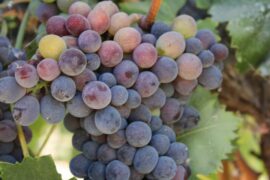Interest in organic wine is growing, with more and more vineyards transitioning to greener production methods that avoid artificial fertilizers and synthetic pesticides.
What is Organic Wine?
For a wine to be labeled organic, both the cultivation of grapes and the winemaking process must meet certain criteria. These criteria mainly involve stricter regulations on the use of chemical pesticides and prohibit the use of synthetic nitrogen fertilizers.
Before a vineyard can be certified organic, it must undergo a conversion period of three years, during which the production practices are adjusted to meet organic standards.
Certification and Control of Organic Wine
To be classified as organic, wine must be certified by an independent organization, which verifies that the wine complies with the EU’s rules for organic farming and organic winemaking.
Is Organic Wine a New Trend?
Some winemakers have long followed organic practices, even without formal certification. In cases of particularly bad weather, they might apply minimal treatment to their crops. However, since a vineyard must operate organically for three years before it can be certified, these occasional treatments can prevent them from obtaining certification.
Some in the industry claim, “What’s so special about organic? Organic winegrowers are just doing what they’ve always done!” There is some truth to this, although the use of sulfur in agriculture dates back 2,000 years, and by the 1600s, certain metals were known to be effective against pests.
Agricultural Changes in the 20th Century
After World War I, farming practices became more industrialized, and synthetic nitrogen fertilizers were introduced on a large scale. In the 1960s and 70s, chemical pesticides for pests and weeds also became widespread. While these methods led to larger harvests, they also depleted soil health and reduced biodiversity.
Organic viticulture began on a small scale in the 1960s but didn’t gain significant traction until the 1980s. The EU introduced its first regulations for organic farming in 1991, and interest has grown rapidly since the early 2000s. By 2018, 3.5% of the world’s vineyard acreage was organic, with 90% of that located within the EU.
Dry Climates Benefit Organic Growers
Since it’s harder to prevent fungal infections without chemical pesticides, organic farming is easier in dry, warm climates. As a result, most organic vineyards are located in regions around the Mediterranean. However, cooler and wetter climates are not a barrier, as organic wine production also thrives in places like Germany, Austria, and northern France.
How Does Organic Farming Differ From Conventional Methods?
Unlike conventional pesticides, which penetrate the plant and act from within, traditional treatments like lime, copper, and sulfur stay on the surface of the plant. Conventional pesticides are not washed away by rain and may leave residues in the grapes, and thus, in the wine. However, the amounts are minimal.
Biological Alternatives for Pest Control
Organic growers cannot use chemical pesticides. Instead, they rely on biological methods such as natural predators, like birds, to combat pests, or pheromone capsules to confuse and disrupt insects like larvae. Additionally, lime and sulfur dioxide are permitted in limited amounts for disease control, as these substances wash away with rain.
Natural Fertilizers Instead of Synthetic Ones
Artificial nitrogen fertilizers are not allowed in organic farming. Instead, compost and natural fertilizers are used to enrich the soil, promoting a healthy ecosystem full of beneficial microbes.
Rather than eliminating weeds between the vines, organic farmers often leave them in place to attract beneficial insects and provide competition for water, which strengthens the vines’ root systems. After the growing season, the weeds are plowed under to serve as fertilizer.
Fewer Additives in Organic Winemaking
To meet EU standards for organic wine, fewer additives and processing aids are permitted compared to conventional winemaking. For example, only 45 substances are allowed in organic winemaking, compared to 63 for conventional production.
Additionally, the allowable levels of sulfur dioxide are lower: 100 mg per liter for red wines (compared to 150 mg for conventional wines) and 150 mg for white and rosé wines (compared to 200 mg for conventional counterparts).
Is Organic Wine Healthier?
Since organic farming has stricter regulations regarding chemical pesticides, synthetic fertilizers, and additives, it’s natural to wonder if organic wine is healthier. However, the finished wine contains such minimal amounts of harmful substances that it makes no significant difference in terms of health.
The main health concern remains the alcohol itself, which causes hangovers and other adverse effects. However, organic wines do make a difference in other areas, particularly for the environment and the workers who cultivate the grapes.
Other Benefits of Organic Wine
Organic farming offers several advantages over conventional farming. Energy consumption is typically lower, as are costs for pesticides. Additionally, organic practices reduce soil depletion and increase biodiversity, creating a more balanced ecosystem in and around the vineyard.
On the downside, organic farming requires more labor, and there’s a higher risk of losing the harvest. Yields may also be slightly lower.
Organic Wine Labels Across Different Languages
The term for organic farming varies by language: ecológico in Spanish, biologique in French, biologico in Italian, and organic in English. Regardless of the language or certification body, the standards for organic wine sold in the EU are the same.





















































